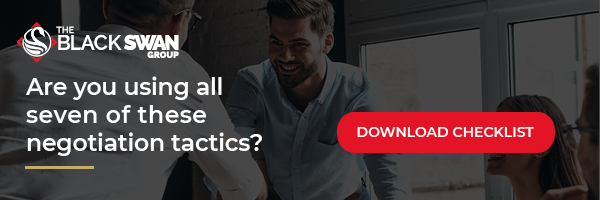Many sales negotiations have moved online during the COVID-19 pandemic. Instead of sitting across the table from someone, sales teams are now hopping between phone calls and Zoom calls to engage the other side and close deals.
Just because your sales negotiation opportunities may have moved from the physical world to the digital world doesn’t mean you need to forget the Black Swan skills and teachings you’ve learned over the years. In fact, our guidelines still apply to virtual sales negotiations.
With that in mind, here are three tactics to keep in mind when you find yourself negotiating with your counterpart over email, the phone, or the computer screen.
1. Use the Rule of 3
The Rule of 3 is a skill that’s designed to get your counterpart to confirm their position three times before you move forward. It helps you gauge how solid the other side’s commitment to a deal is, which enables you to figure out the best way forward in a virtual negotiation.
We execute the Rule of 3 by using three tactics together:
- Labels™
- Mirrors™
- Paraphrasing
Start by using a Label to identify the sentiments in the negotiation that haven’t yet been openly addressed. You might say something like: It seems like this has probably been top of mind for you for a while. Regardless of how they respond, you’ll get a great deal of information.
For the purposes of this post, let’s imagine your counterpart responds like this: Well, I guess you could say that. We’ve been looking for a fix for a while now.
Respond by Mirroring the other side. For a while now? Here’s your second confirmation.
Now, it’s time to paraphrase: Just so I have this straight: You’ve been thinking about this problem for a while now and have been wondering how we might be able to fix it. There’s your third.
2. Use No-Oriented Questions™
We all know what it’s like for a salesperson to try to use the yes momentum on us. It seems like we’re being coerced into something we don’t want to do, and we don’t like it.
On the flip side, human nature wires us to prefer being able to say no. When we’re able to say no, we feel protected.
Use this to your advantage by using No-Oriented Questions, which are questions that are designed to elicit the no response. It might seem counterintuitive, but take my word for it.
Here is a list of No-Oriented Questions to get you thinking in the right direction:
- Would you be against letting us take a crack at this?
- Would you be against us doing a demo to see how this stuff works?
- Are you against moving forward?
We’ve found that third question to be particularly effective for our clients.
For the best results, lead into No-Oriented Questions with an Accusation Audit™: This is going to seem rigid and might come across as a bit intrusive, (dynamic silence - count Mississippi’s) are you against moving forward?
3. Respect Your Counterpart’s Time
The Black Swan Group always advises clients to push for face-to-face meetings. During COVID-19, this changes a bit. Instead of moving for an in-person meeting, you should be trying to drive your counterpart to a video meeting.
But be cautious. Be sure to demonstrate that you respect the other side’s time. Any counterpart you interact with will appreciate you when you respect their time.
Remember, the average salesperson is seen as pushy and sleazy. By clearly articulating how you respect your counterpart’s time, you begin to change that perception.
So lay something like this out over an email: I know you’re busy. I imagine you might not even have any time. Would it be impossible for us to spend 20 minutes in a Zoom meeting to iron this out and answer any questions you might have?
When you respect your counterpart’s time and allow yourself to answer all of their questions thoroughly, no one is going to deny such an opportunity.
Try these tactics out during your next virtual sales negotiation, and you should start to see some better results.
To learn even more skills you can execute during a virtual negotiation, check out our free guide: Ultimate Negotiation Checklist for Sales Teams.


